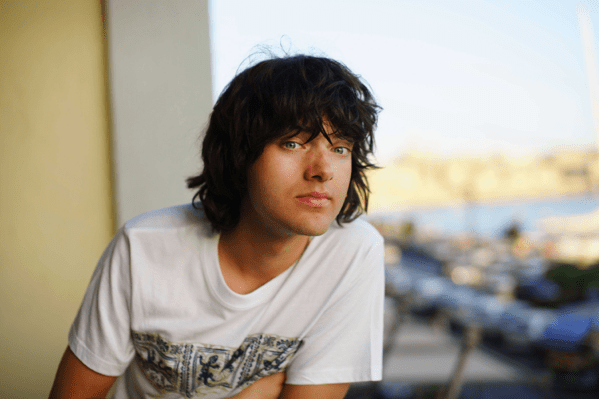“For society to progress, we should not only move forward but also cleanup after ourselves.”1

By NOAA | Courtesy of Wikimedia Commons
Over the last forty years, our oceans have been filling with tons of plastic debris. The plastic is carried by the ocean currents and it all converges in five major accumulation zones, commonly called “Garbage Patches.”2 Many scientists predict that if this problem is not solved, there will be major consequences. Garbage will block the sunlight in the oceans, resulting in many species of sea plants and animals dying. Moreover, the environment will be affected in such ways that the entire food chain of the world will suffer major changes. Dutch inventor Boyan Slat has come up with an idea to solve this problem.3
Boyan Slat is a 24-year-old Dutch inventor, who has been interested in engineering projects since he was very young. At the age of fourteen, he even set a Guinness World Record by launching 213 water rockets at the same time.4 When he was sixteen, he went diving in the waters of Greece and was so surprised to see more plastic underwater than fish. That was the moment when Slat began the idea of cleaning up the ocean. Over the last forty years, millions of tons of plastic have entered the oceans creating huge garbage patches. The largest such patch is located between Hawaii and California. After his trip to Greece, Boyan became obsessed with this problem. During high-school, all of his science projects were about understanding this problem and trying to solve the “million-dollar” question “why this cleanup is considered impossible?”5

After high-school, Boyan was invited to TEDtx to tell the world his idea. At first, his ideas didn’t seem to be really interesting to the public, so he went on with his life. He started working as an aerospace engineer in TU Delft, but he just couldn’t let go of his idea. But the simple thought of not being able to come up with a solution to this major problem was killing him. He was thinking about the terrible consequences, in several years, for the planet if no one did anything.6
After several months he came into the spotlight again because some news sites had picked up his TED speech and became interested in his story. Slat even dropped out of college to pursue his dream.7
He had always enjoyed solving problems and puzzles. But this time was going to be different. This time the puzzle was to get rid of the plastic in the oceans. He just had to find the perfect pieces to accomplish that. At the young age of eighteen, he founded a non-profit organization called The Ocean Cleanup, in order to develop new technology to tackle this almost impossible task.8
And this is when the real adventure began for Slat. Instead of picking up all the plastic bottles with nets, which according to experts it would cost millions of dollars and take thousands of years, his idea was to use the power of natural currents to gather plastic into long floating rubber barriers. But developing this great plan wasn’t an easy task. It required money, time, and many experts in different fields. In an interview, Slat said “When I started, I thought I would likely fail, and I still might, but considering the scale of the problem, it was important to at least try.”9
His ideas started coming together when several experts, such as engineers, oceanographers, recycling companies, and scientists volunteered to complete a study, which ended up indicating that the The Ocean Cleanup project had a feasible and viable method for removing large amounts of plastic. But this was only the first step. Slat still needed a lot of money to start the project. So his next step was to take his story and project to the rest of the world. He has since gained the support of 160 countries, 38,000 funders, and collected over 2 million USD. With this money, he was closer to accomplishing his dream, but, again, this was just another piece of a big puzzle.10

Later, The Ocean Cleanup started developing prototypes, then getting into trials, failing and learning from mistakes, and finally the got it right. They mapped an area of 3.5 million squared kilometers of plastic and marine debris, known as the “great pacific garbage patch.” After that, Slat gave an interview arguing that most people had an image of this patch as an island where you can practically walk on, but that couldn’t be more wrong. It stretches for millions of kilometers and it would take thousands of years to clean it up.11 So he targeted that area to clean first. The first Ocean Cleanup system was launched on September 8, 2018. He is hoping to clean up to 50% within five years.12
This amazing story is only getting started, so if you want to follow the progress of this project, you can follow their official organization page (www.theoceancleanup.com).
- The Ocean Cleanup, “The largest Cleanup history,” The Ocean Cleanup, June 6, 2017. Accessed September 8. www.theoceancleanup.com. ↵
- NOAA, “Great Pacific Garbage Patch,” National Geographic, June 5, 2015. Accessed September 8. https://www.nationalgeographic.org/encyclopedia/great-pacific-garbage-patch/. ↵
- U.S. Government Publishing Office, “Endangered status for North Pacific and North Atlantic Right Whales,” (Federal register: Vol. 73, No. 45. Thursday, 2008), 12024-12030. ↵
- Viveke Venema, “The Dutch boy mopping up a sea of plastic,” BBC News, October 17, 2017. Accessed September 7. https://www.bbc.com/news/magazine-29631332. ↵
- Susan Caminiti, “Thiel backing 22-year-old’s dream to clean up world’s oceans,” CNBC.com, April 22, 2017. Accessed September 5. https://www.cnbc.com/2017/04/20/thiel-benioff-backing-22-year-olds-dream-to-clean-up-worlds-oceans.html. ↵
- The Ocean Cleanup, “How it all began,” The Ocean Cleanup, June 6, 2017. Accessed September 8. www.theoceancleanup.com. ↵
- The Ocean Cleanup, “How it all began,” The Ocean Cleanup, June 6, 2017. Accessed September 8. www.theoceancleanup.com. ↵
- Susan Caminiti, “Thiel backing 22-year-old’s dream to clean up world’s oceans,” CNBC.com, April 22, 2017. Accessed September 5. https://www.cnbc.com/2017/04/20/thiel-benioff-backing-22-year-olds-dream-to-clean-up-worlds-oceans.html. ↵
- Viveke Venema, “The Dutch boy mopping up a sea of plastic,” BBC News, October 17, 2017. Accessed September 7. https://www.bbc.com/news/magazine-29631332. ↵
- The Ocean Cleanup, “Milestones,” The Ocean Cleanup, June 6, 2017. Accused September 8. www.theoceancleanup.com. ↵
- Marian Liu, “Great Pacific Garbage Patch Now Three Times the Size of France,” CNN, 23 Mar. 2018. Accessed September 6 2018. www.cnn.com/2018/03/23/world/plastic-great-pacific-garbage-patch-intl/index.html. ↵
- The Ocean Cleanup, “Milestones,” The Ocean Cleanup, June 6, 2017. Accessed September 8. www.theoceancleanup.com. ↵



78 comments
Hailey Stewart
The recent declaration of the UN stating that we have about 12 years to reverse climate change is what attracted me to this article. I am glad that there are people who are not only calling attention to this issue, but also taking action. I first heard about the Garbage Patch in high school and was blown away that more action has not ben taken. I also read on the Washington Post that by 2050, the amount of plastic in the ocean will have surpassed the amount of fish. This is insane, and I will be following the progress of this project, and am hoping for the best.
Enrique Segovia
Sat’s work is really important for the world; his organization may change the world drastically, and it will improve ocean life. It is incredible to think that he obtained a Guinness World Record at such a young age, and that he has such an amazing and conscientious mind to help the world. The Ocean Cleanup project has great potential and how Slat has managed to fund his campaign is remarkable. I hope that he achieves his goal and the plastic is removed from the oceans.
Sofia Andrade
The garbage patch is a completely new term for me. I had not heard of the garbage patch before but it was interesting to know that due to the ocean currents there are two specific spots where garbage is accumulated. I am glad that there is someone like Slat who is concerned about our environment and wants to make a change. He had such a great passion to help the environment that now The Ocean Cleanup was recently launched.
Emily Jensen
My favorite quote from the entire article has to be the very first line, what an intro! The images provided really helped the author hit the point of the article home: We are responsible. I enjoyed reading about Boyan Slat’s journey to success, quite an interesting story to tell. I liked that the author left the link to follow the projects progress.
Harashang Gajjar
Communities can ban plastic bags, and consumers can decide to stop purchasing non-biodegradable disposable products. Environmental groups are already working with seafood industry players and local fishing communities alike to collect and recycle abandoned fishing nets, but that effort needs to be scaled up. We need more products made out of old fishing nets.
Kacey Diaz
Boyan Slat is a very inspiring and determined individual who wanted to see change and actually did something about it. We all know that there is a bunch of trash in the Ocean but we also don’t see many people doing anything about it. Slat realized this and he became so invested in his idea for change. Now after reading this article all I can thing about is leaving things better then when you found them.
Faten Al Shaibi
This is the first time I have heard of this project, it is a great idea, I was excited to know more about “The Ocean cleanup project” and for the progress they just have made so far, I think ocean pollution is a real problem ,some may not think so. The problem is serious and dangerous, all countries must participate in this project and help it. the article is good and simple I like it.
Alexander Manibusan
I must admit, when I first heard about the Pacific garbage patch as a sophomore in high school, I knew that it was a problem, but a problem nonetheless. It wasn’t until I saw a video about the plastic and trash in the ocean that I finally understood the gravity of the situation. The video also mentioned Boyan Slat, and it was very inspiring to see someone so determined and committed to clean up the ocean with innovative techniques. I admire his determination and I hope he reaches his goal with Ocean Cleanup.
Pedro Gonzalez Aboyte
I have heard of the Pacific Garbage Patch and, at the time, I did not really realize how much of a problem it was and how it could and will affect our everyday lives in the future. It’s incredible how a man like Boyan Slat, who has always been passionate about inventing and solving problems, decided to take on such a gigantic problem. He even decided to drop out of school to pursue this challenge. He seems to be advancing and achieving his goal little by little. It is people like these who inspire me to do great, even if its little things, they can cause a huge impact.
Sienna Guerra
It is inspiring to hear of projects like the one you detailed in your article. I like this idea because with the over pollution and danger to our nature and wildlife, it will not only help but protect the animals as well as ourselves. We need to focus efforts to stop pollution as well as keep finding better ways to clean up after ourselves.The idea of gathering plastic into rubber barrier is great considering it will filter out all the waste and pollution in a smoother transition.